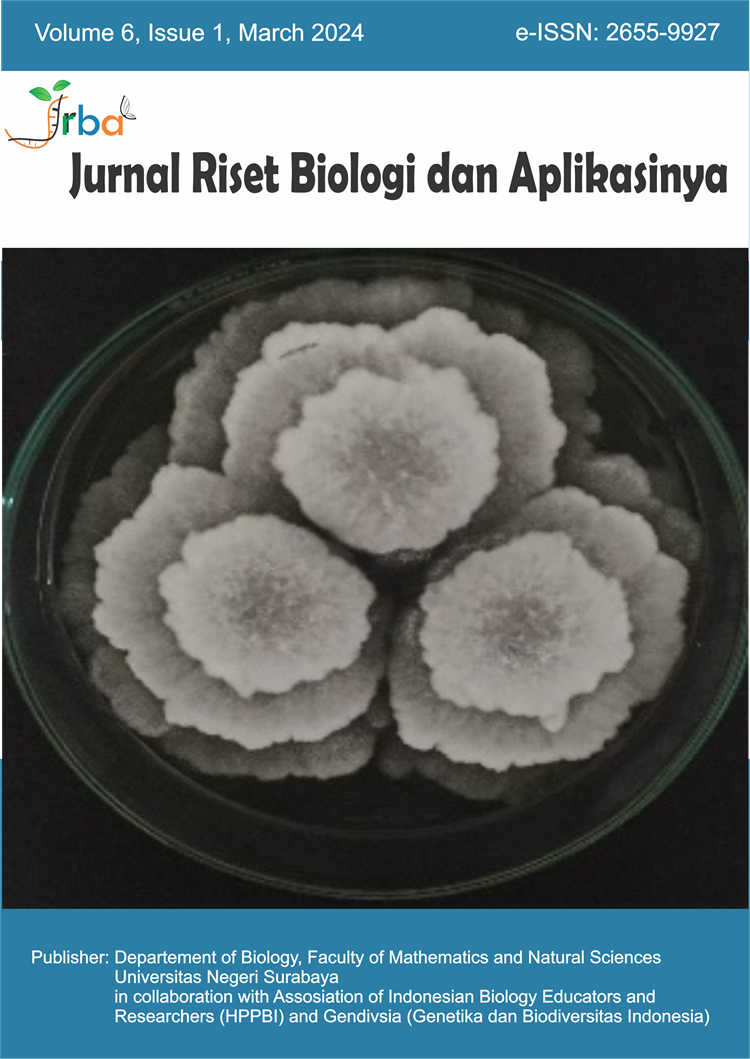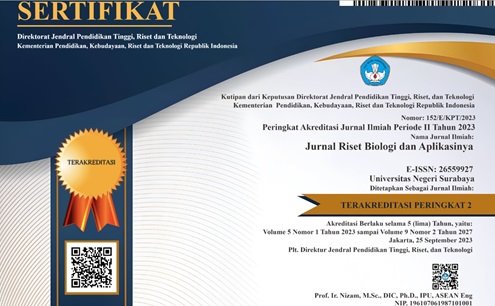Relative Frequency (Composition) of Anopheles sp. Mosquitoes as Malaria Vectors in Kulon Progo District Special Region of Yogyakarta
DOI:
https://doi.org/10.26740/jrba.v6n1.p20-33Abstract
Malaria is caused by Plasmodium infection transmitted Anopheles sp. One of the obstacles in malaria control is the variation of Anopheles sp. Species which have various characteristics and behaviour, so it’s very important to understand the species of Anopheles sp. with aim to develop the disease control program. This study was conducted in Kulon Progo Regency, Yogyakarta, one of the malaria endemic areas in Indonesia. Data collection of Anopheles sp. species diversity was carried out through landing collection inside and outside people’s homes at 18.00 - 06.00 WIB. Observations of abiotics factors in the habitat of Anopheles sp. larvae was carried out around the landing collection location. The result of research conducted in the Samigaluh, Kalibawang, and Pengasih Sub-Districts showed that the most common species found was Anopeheles vagus. The dominance of Anopheles vagus occurred in the Kalibawang and Pengasih dictricts, while in the Samigaluh Sub-Districts it became the second most among other species. Measurement of abiotic factors in the habitat of Anopheles sp. larvae through the parameters of temperature, air humidity, pH DO of water shows that the location where the larvae were found can support larval breeding and growth. That can be a factor in the large population of Anopheles sp., especially Anopheles vagus, which is a known vector of malarias based on research and its vectorial capacity.
References
Aida, P. N., Astuti, F. D., & Azka, A. (2022). Keanekaragaman Spesies dan Bionomik Anopheles spp. Pada Daerah Endemis Malaria di Indonesia. ASPIRATOR - Journal of Vector-Borne Diseases Studies, 14(2), Article 2. https://doi.org/10.58623/aspirator.v14i2.11
Dalilah, D., Apriliani, F. A., Prasasty, G. D., Handayani, D., Susilawati, S., & Pahlepi, R. I. (2022). Keragaman Spesies Nyamuk di Dusun Sukoharjo, Desa Bayung Lencir, Kabupaten Musi Banyuasin. Jurnal Kedokteran Dan Kesehatan : Publikasi Ilmiah Fakultas Kedokteran Universitas Sriwijaya, 9(1), Article 1. https://doi.org/10.32539/JKK.V9I1.16539
Dinas Kesehatan Kabupaten Kulon Progo. (2023). Profil Kesehatan Kabupaten Kulon Progo Tahun 2022. Dinas Kesehatan Kabupaten Kulon Progo.
Kemenkes RI. (2021). Laporan Kinerja 2021 Direktorat Jenderal P2P. Kementrian Kesehatan RI.
Krismahardi, A. (2023). Hubungan Keberadaan Kandang Hewan Ternak dan Penggunaan Kelambu terhadap Kejadian Malaria di Indonesia: Meta Analisis 2013 - 2022. Buletin Keslingmas, 42(1), Article 1. https://doi.org/10.31983/keslingmas.v42i1.9455
Lesmana, S. D., Maryanti, E., Haslinda, L., Putra, W., Fadhillah, M. N., Anwar, F. R., & Lutfi, R. (2021). Identification of Anopheles Mosquito Species as Malaria Vector In Riau, Indonesia. Jurnal Ilmu Kedokteran (Journal of Medical Science), 14(1), Article 1. https://doi.org/10.26891/JIK.v14i1.2020.24-32
Nisrina, H., Sumanto, D., & Widodo, S. (2020). Pengasapan Kandang Ternak: Perilaku Potensial Peningkatan Risiko Gigitan Anopheles pada Penduduk Daerah Endemik Malaria. Jurnal Kesehatan Masyarakat Indonesia, 15(1), Article 1. https://doi.org/10.26714/jkmi.15.1.2020.35-41
Novianto, D., Hadi, U. K., Soviana, S., Supriyono, S., Rosmanah, L., & Darusman, H. S. (2022). Diversity of mosquito species and potential arbovirus transmission in long-tailed macaque (Macaca fascicularis) breeding facilities. Veterinary World, 15(8), 1961. https://doi.org/10.14202/vetworld.2022.1961-1968
Pahlepi, R. I., Santoso, Taviv, Y., Riandi, M. U., Febriyanto, Mahdalena, V., Permadi, I. G. W., Komaria, R. H., Asyati, D., Setiawan, A., Emawati, & Anggraini. (2022). Bionomik Anopheles spp. Di Kecamatan Sindang Beliti Ulu Kabupaten Rejang Lebong Provinsi Bengkulu Tahun 2021. ASPIRATOR - Journal of Vector-Borne Diseases Studies, 14(2), Article 2. https://doi.org/10.58623/aspirator.v14i2.14
Reid, J. A. (1968). Anopheline mosquitoes of Malaya and Bornea. Anopheline mosquitoes of Malaya and Bornea., 31. https://www.cabdirect.org/cabdirect/abstract/19691000156
Rushadi, R., Hestiningsih, R., Kusariana, N., & Yuliawati, S. (2021). Kepadatan Nyamuk Di Wilayah Buffer Pelabuhan Muara Sabak (Studi di Kelurahan Muara Sabak Ilir Kabupaten Tanjung Jabung Timur, Jambi). Jurnal Kesehatan Masyarakat, 9(2), Article 2. https://doi.org/10.14710/jkm.v9i2.28745
Senjarini, K., Oktarianti, R., Abdullah, M. K., Sholichah, R. N., Tosin, A., & Wathon, S. (2020). Morphological Characteristic Difference Between Mosquitoes Vector for Malaria and Dengue Fever. https://repository.unej.ac.id/xmlui/handle/123456789/104212
Sinum, I. M., Kurniawan, B., Soleha, T. U., & Mutiara, H. (2023). Identifikasi dan Analisis Kepadatan Nyamuk Anopheles sp. Yang Berpotensi sebagai Vektor Malaria berdasarkan Lingkungan Kecamatan Teluk Pandan, Kabupaten Pesawaran.
Utami, T. P., Hasyim, H., Kaltsum, U., Dwifitri, U., Meriwati, Y., Yuniwarti, Y., Paridah, Y., & Zulaiha, Z. (2022). Faktor Risiko Penyebab Terjadinya Malaria di Indonesia: Literature Review: Risk Factors Causing Malaria in Indonesia : Literature Review. Jurnal Surya Medika (JSM), 7(2), Article 2. https://doi.org/10.33084/jsm.v7i2.3211
Wahyuni, I., Senjarini, K., Oktarianti, R., Wathon, S., & Nur Uswatul Hasanah, L. (2018). Identifikasi Morfologi Spesies Sibling Anopheles vagus vagus dan Anopheles vagus limosus Asal Desa Bangsring, Banyuwangi. BIOSFER : Jurnal Biologi Dan Pendidikan Biologi. https://doi.org/10.23969/biosfer.v3i1.1585
Wathon, S., Astikaningrum, D., Ardyah, N. P. C., Oktarianti, R., & Senjarini, K. (2023). In silico exploration of the potential barcode DNA in Anopheles sp., a malarian vector from Indonesia. Jurnal Biolokus: Jurnal Penelitian Pendidikan Biologi Dan Biologi, 6(1), Article 1. https://doi.org/10.30821/biolokus.v6i1.1749
Weeraratne, T. C., Surendran, S. N., Reimer, L. J., Wondji, C. S., Perera, M. D. B., Walton, C., & Parakrama Karunaratne, S. H. P. (2017). Molecular characterization of Anopheline (Diptera: Culicidae) mosquitoes from eight geographical locations of Sri Lanka. Malaria Journal, 16(1), 234. https://doi.org/10.1186/s12936-017-1876-y
World Health Organization (WHO). (1975). Manual on practical entomology in malaria. Part 2, Methods and techniques. World Health Organization ; [H.M.S.O.].
Yahya, Y., Haryanto, D., Pahlevi, R. I., & Budiyanto, A. (2020). Keanekaragaman Jenis Nyamuk Anopheles di Sembilan Kabupaten (Tahap Pre-Eliminasi Malaria) Di Provinsi Sumatera Selatan. Vektora : Jurnal Vektor Dan Reservoir Penyakit, 12(1), Article 1. https://doi.org/10.22435/vk.v12i1.2621
Yuniawan, F. S. A., Utomo, B., & Arwati, H. (2019). Variety of Anopheles mosquito in Salamwates Village, Dongko Subdistrict Trenggalek District, East Java Province. Jurnal Kesehatan Masyarakat, 15(2), Article 2. https://doi.org/10.15294/kemas.v15i2.15937
Downloads
Published
How to Cite
Issue
Section
License
Copyright (c) 2024 Jurnal Riset Biologi dan Aplikasinya

This work is licensed under a Creative Commons Attribution-NonCommercial 4.0 International License.
 Abstract views: 290
,
Abstract views: 290
, PDF Downloads: 378
PDF Downloads: 378












